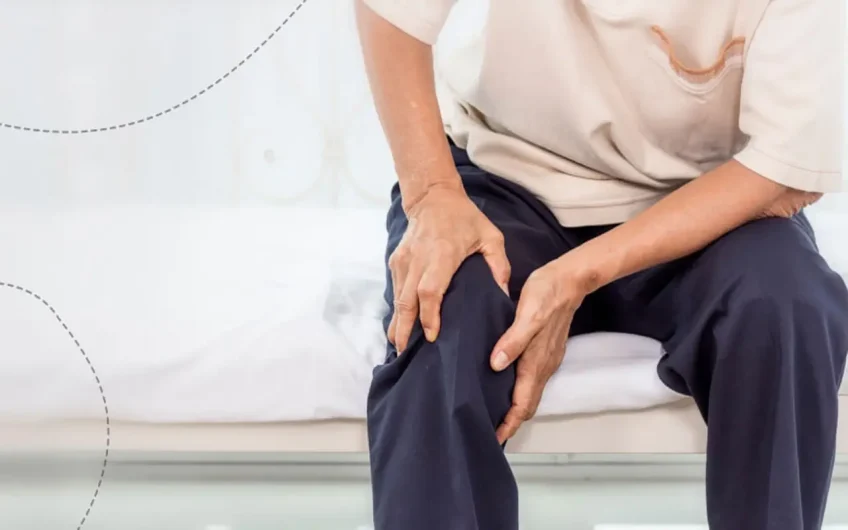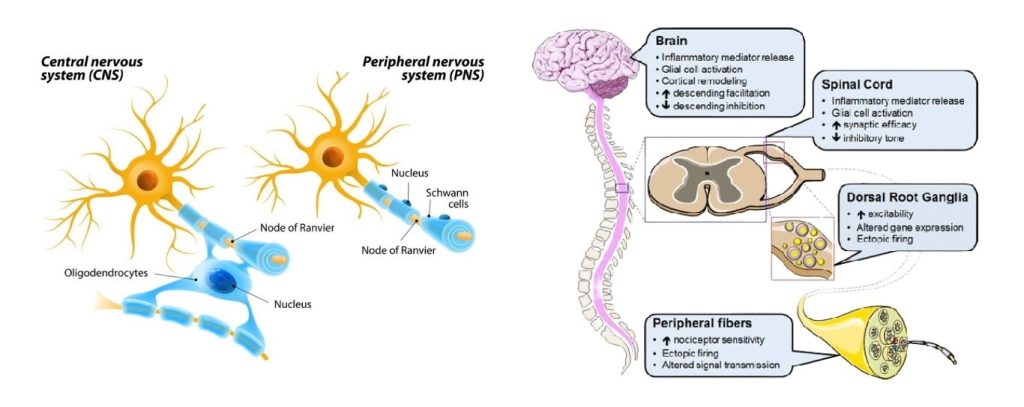Sorry, nothing in cart.
What is Neuropathic Pain?
- By admin
- |
- General Blog
- |
Neuropathic pain, also known as neuralgia or nerve pain, develops when a medical problem affects the nerves that transmit sensations to the brain. Nerve pain can different from other types of pain.
Nerve pain can affect any nerve in your body, however it primarily affects certain nerves. For example:
Central neuropathic: Damaged nerve fibers deliver incorrect signals to your body’s pain centers, resulting in neuropathic pain. The nerve function may vary at the site of nerve damage and in sections of your central nervous system (central sensitization).
Peripheral neuropathic: Peripheral neuropathy occurs when nerves outside of the brain and spinal cord (peripheral nerves) are injured. This illness frequently produces weakness, numbness, and pain in the hands and feet. It can also have an impact on other areas and activities of the body, such as digestion and urination.
Causes of Neuropathic Pain
- An alcohol use disorder: One of the most common side effects of persistent alcohol usage is alcoholic neuropathy. The nerves are damaged as a result of alcohol’s direct toxic action and the starvation it causes. Patients present with lower extremity discomfort, ataxia.
- Diabetes: Diabetes can cause nerve damage, which is known as diabetic neuropathy. Symptoms of different forms of nerve injury vary. Symptoms might range from foot pain and numbness to problems with the function of your internal organs including your heart and bladder.
- HIV/AIDS: HIV can cause nerve damage throughout the body, resulting in severe discomfort or paralysis, a condition known as neuropathy. People with advanced HIV are more likely to develop neuropathy. Myelopathy of the vacuole. This syndrome develops when microscopic holes form in the fibers of the spinal cord’s nerves.
- Parkinson’s disease: Parkinson’s disease is a central nervous system (brain and spinal cord) illness that impairs movement. Brain cells that produce the neurotransmitter dopamine die for unexplained reasons.
- Complex regional pain syndrome (CRPS): The majority of CRPS disorders are caused by injury to or dysfunction of the tiny peripheral C-fiber nerve fibers that convey pain signals to the brain. (The peripheral nervous system is responsible for nerve transmission from the brain and spinal cord to the rest of the body.)
- Shingles: The major symptom of post-herpetic neuralgia is intermittent or chronic nerve pain in a shingles-affected area of your skin. It is described as scorching, stabbing, shooting, hurting, throbbing, or similar to electric shocks.
Symptoms of Neuropathic Pain
- Severe pain, such as shooting, throbbing, or burning
- Sensations similar to electricity
- Numbness
- A tingling sensation, also known as “pins and needles”
- Decreased use of the senses, for example, trouble sensing temperature
- Skin with a mottled or crimson appearance
- Itchiness
- Changes in pain caused by the weather
Diagnosis
A doctor will do an interview and a physical exam to determine neuropathic pain. They may inquire as to how you would describe your pain, when it occurs, or whether something specific causes the pain. The doctor will also inquire about your neuropathic pain risk factors and may order blood and nerve tests.
Treatment of Neuropathic Pain
Numerous alternative therapies are effective in treating neuropathic pain. These treatments, which frequently use medicine in combination, consist of:
Complementary Therapies
A number of complementary therapies can aid in the relief of neuropathic pain. These therapies, which are frequently utilized in conjunction with pharmaceuticals, include:
Physical Therapy or Occupational
Physical therapy help in the treatment of neuropathy and may alleviate some symptoms such as pain and weakness. The reason of neuropathy and the precise content of a person’s exercise program, on the other hand, may alter the efficacy of physical therapy.
Stimulation with electricity
TENS (transcutaneous electrical nerve stimulation) is a type of therapy that uses low-voltage electric pulses to relieve pain and discomfort. An at-home TENS unit is a tiny device that is wired to electrodes (adhesive pads).
Acupuncture
This approach alters your body’s reaction to pain. Many patients with neuropathy seek relief from persistent pain through acupuncture. Acupuncture also increases blood flow, which helps to repair nerve damage.
Massage treatment
Massage treatment help to release of nerve compression and promotion of increased nerve tissue healing, it can lessen the consequences of injury. Relief of pinched nerves and mending of injured neural tissues improves sensation by reducing unpleasant sensations such as pins and needles and numbness.
Medication
Various Medicine have been treat neuropathic pain. The majority of these drugs are taken off-label, which means that they were approved by the FDA to treat other ailments before being recognized as being effective to treat neuropathic pain. Pregabalin and Gabapentin Are used to treat neuropathic pain.
FAQs
Q1) what are the types of neuropathic pain?
Ans: There are 4 types of neuropathic pain:
- Neuropathy of the motor system.
- Neuropathy of the senses.
- Neuropathy of the autonomic nervous system.
- Neuropathies that combine.
Q2) what does neuropathic pain feel like?
Ans: Symptoms of neuropathic pain may include one or more of the following: Pain that appears out of nowhere (spontaneous pain): This could include tingling, numbness, or a “pins and needles” sensation, as well as searing, stabbing, or electric shock-like pain.
Q3) what is the best way to treat nerve damage?
Ans: If your nerve is simply damaged, you may recover without surgery over time. Nerves regenerate slowly, often taking months to repair. Nonsurgical treatment options for these minor nerve injuries include medication, physical therapy, and massage therapy. Damaged nerves can be rebuilt or repaired by peripheral nerve surgery.
Q4) which vitamin is best for nerve repair?
Ans: The B vitamins have the ability to aid in nerve regeneration. This could be because B vitamins aid in the regeneration of brain tissue and the enhancement of nerve function. B vitamins may also help with pain and inflammation relief.
Q5) what are signs of nerve damage?
Ans: The following are the most prevalent signs of a nerve condition:
- Numbness, discomfort, tingling, or burning sensations in your limbs or extremities.
- Unexplained weakness, muscle weakness, or paralysis.
- A headache that lasts, appears suddenly, or is “strange”
- Issues with coordination.
- One leg is in excruciating discomfort.
Q6) what foods are bad for neuropathy?
Ans: Gluten, excessive alcohol, added sweets, refined grains, unhealthy fats, and overly processed foods are all foods to restrict or avoid.
Q7) is walking well for neuropathic pain?
Ans: Walking can help relieve the pain and other symptoms of neuropathy caused by nerve damage in your feet and lower legs. Walking and other modest aerobic workouts can help persons with neuropathy, which is a group of diseases including disease and injury to the peripheral nerves.
Q8) which juice is good for nerves?
Ans: Pomegranates include ellagitannins, which are polyphenols that function as antioxidants and alleviate inflammation in the body. They help your nerves by protecting them from inflammation and oxidative stress. Its magnesium content benefits neurons and muscles.
Q9) what fruits are good for nerve damage?
Ans: Berries, peaches, cherries, red grapes, oranges, and melons, among other fruits and vegetables, are high in antioxidants, which assist to minimize inflammation and nerve damage. Furthermore, grapes, blueberries, and cranberries have been proven to be high in resveratrol, a potent anti-inflammatory molecule. Zucchini.
Q10) can nerve pain repair itself?
Ans: Schwann cells can aid in the regeneration and restoration of injured nerves. Damaged nerves can regenerate at a pace of roughly 1 inch per month, or 1 millimeter every day. If there is considerable scar tissue or a gap between the clipped nerve endings, surgery is required.
 English
English
 French
French  German
German

